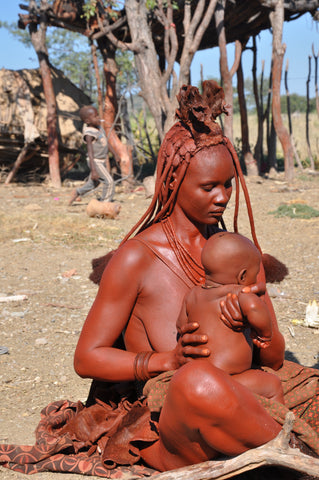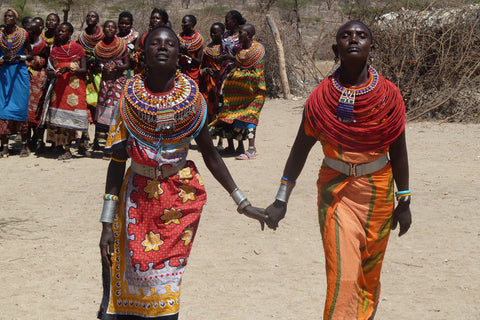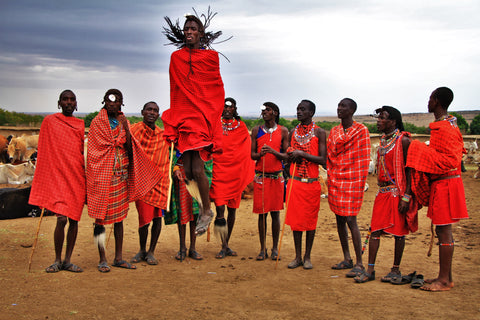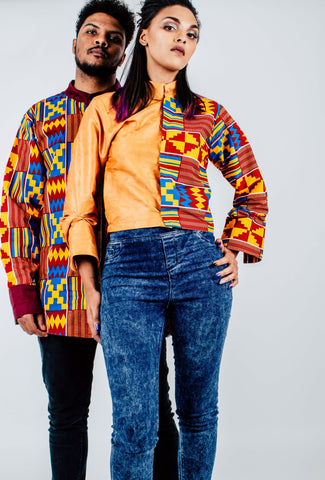An Overview of the African Fashion Timeline

The global fashion industry has not always referenced African fashion in the right way. Most people relate African fashion with exotic or tribal fashion, constantly simplifying it to loin clothes and animal hide. Although these are a point of reference, it is important to remember that Africa is a large continent. As such, the African fashion story is influenced by numerous societies.
Throughout the continent, different tribes and communities have traditional attire. Today, these traditional attires are commonly worn on special occasions. This, however, was not the case ages ago. The traditional attire worn for special occasions today, was once worn every day. Although it is difficult to trace the evolution of historic African fashion due to the lack of recorded facts, there is historical evidence (clothes being passed down through generations, oral history, theater, and art and artifacts) that shows the evolution of African fashion.
Early African fashion
Early African fashion was quite simple. The first form of clothing was mainly made out of materials such as bark cloth, hide, fur, and animal skin. To combine pieces together, they used raffia, and soon, grass was used to make skirts in different parts of Africa.

Women of Rundu, Namibia, wearing bamboo beads skirts and animal skin tops.
Adornment was also crucial because it carried different meanings for different people. For instance, body marks among the Yoruba of West Africa indicated lineage affiliation and for the Nuba women of Sudan, scarification patterns indicated rites of passage. Beads were also used to symbolize power, warrior-hood, age, marital status, beauty, strength, and culture. Different tribes opted for different forms of adornment. The materials used were mainly shells, bones, feathers, wood, animal tails, pressed metals, scarification marks, and ochre paint.


Ochre paint used for beautification and protection against the sun.
Accessories were used to adorn the bare parts of the body. But on special ceremonies and occasions (such as weddings, naming ceremonies, worship, circumcision, funerals, and the birth of a child), Africans would wear intricate jewelry, headgear, animal tails and bells which would create a rich and embellished costume.

Maasai women wearing heavily beaded outfits for a ceremony
There’s also evidence to show that handmade clothes became more complex. As far back as 5,000 BC, Egyptians would weave flax into linen. African weavers created mats, bags, blankets, linen, and clothes embellished with beads, shells, or feathers. Natural dyes were used to create different tribal patterns. As a result, African fashion grew from simple loin clothes to intricately designed full-body attire and accessories.
Trade influence on African Fashion
In the 15th century, when European ships started arriving on the shores of Africa, uncommon items came with the Age of Discovery and Africans were quick to decorate their clothes with these items. As a result, buttons were adopted on clothing, different dying techniques were employed, and decorated textiles became popular.
A good example of the influence of trade on African fashion is the wax print that is commonly associated with traditional African fashion today. The Dutch (industrialist Pieter Fentener van Vlissingen) adopted the wax print from Indonesia in 1846. In an attempt to make a profit, they tried to sell fabric with the wax print (batik) to Indonesians, but the Indonesians quickly recognized that it was not genuine batik because of the small flaws in the fabric. They refused to buy and, in fact, banned the trade of faux batik in the 19th century. However, Ghanaian soldiers serving in the royal Netherlands army between 1855 and 1872 appreciated genuine batik, but the faux batik was more affordable, so they were willing to purchase it for their relatives back home.
Although trade brought fabric that was produced outside of Africa into the continent, the patterns and fashions themselves were fully African. Before traders arrived on the West African shores, weavers would create intricate patterns for the royals using handlooms. These patterns were very sacred and beautiful. So, naturally, the common population also created other patterns that were equally beautiful but different. When the traders arrived with new fabric, Africans were happy to buy from them and they started asking for specific patterns. Soon, there were many more patterns easily available to willing buyers; but to this day, there is still a distinct royal pattern in numerous African communities.
Although the aesthetic of wax print evokes that of batik, the patterns are filled with culturally specific references and visual cues which are continuously translated into sentiments and ideas in the large world of its consumers.
Africans have invested different narratives into different patterns and textiles. For instance, patterns can be used to show where you are from. Different regions have different names for woven fabric. Maasai from East Africa wear Shukas, Tanzanians wear Kanga, Ghanaians wear Kente, South Africans wear ShweShwe, Nigerians wear Ankara, etc.

Different patterns on African fabric
The effects of Colonization on African Fashion
When traders arrived on the shores of Africa, explorers came too. Soon after, in the late 19th century (1884 -1914) during the Scramble for Africa, African countries were colonized by western European countries. This evoked a significant change in traditional African fashion. Colonizers brought about new laws, and the social dynamics quickly changed. Attire that was once regarded as royal was considered to be primitive, or inappropriate. As a result, numerous Africans conformed to the colonizer’s new rule.
Due to years of colonization, traditional clothing was looked down upon in corporate settings. In rural areas, traditions were still being upheld, but fashion had been influenced by the western dress code. A good example of the impact of colonization on African fashion is the African dress. In many African communities, men draped beautiful fabric over their bodies. Trousers only became popular after the western dress code was popularized. This was evident in the way Africans embraced second hand clothing that was donated to Africans in the 19th century through charitable organizations.

The Maasai dress
African Fashion today
A mainstay of African fashion is traditional African patterns and designs. Africans across the globe still embrace their culture by occasionally wearing their traditional attire, and the current wave of Afrobeats and Afropop has influenced different people from different ethnicities. Young Africans worldwide are slowly reconnecting with their heritage and this has brought a rise of different African inspired styles.
Ghanaian Kente pattern used on modern designs.
African fashion is in a steady mode of transformation. Indigenous, handmade, African fabric is used to create different modern attire. This breathes new life into modern African fashion, while preserving the art, essence, and cultural significance of traditional African fabric. In many ways, the modernization of historic African fashion has helped numerous people to reconnect with the heartbeat of Africa by showcasing the richness and variety of African culture.
Shop SHORMEHD Kente Unisex Apparel at shormehd.com.






Leave a comment